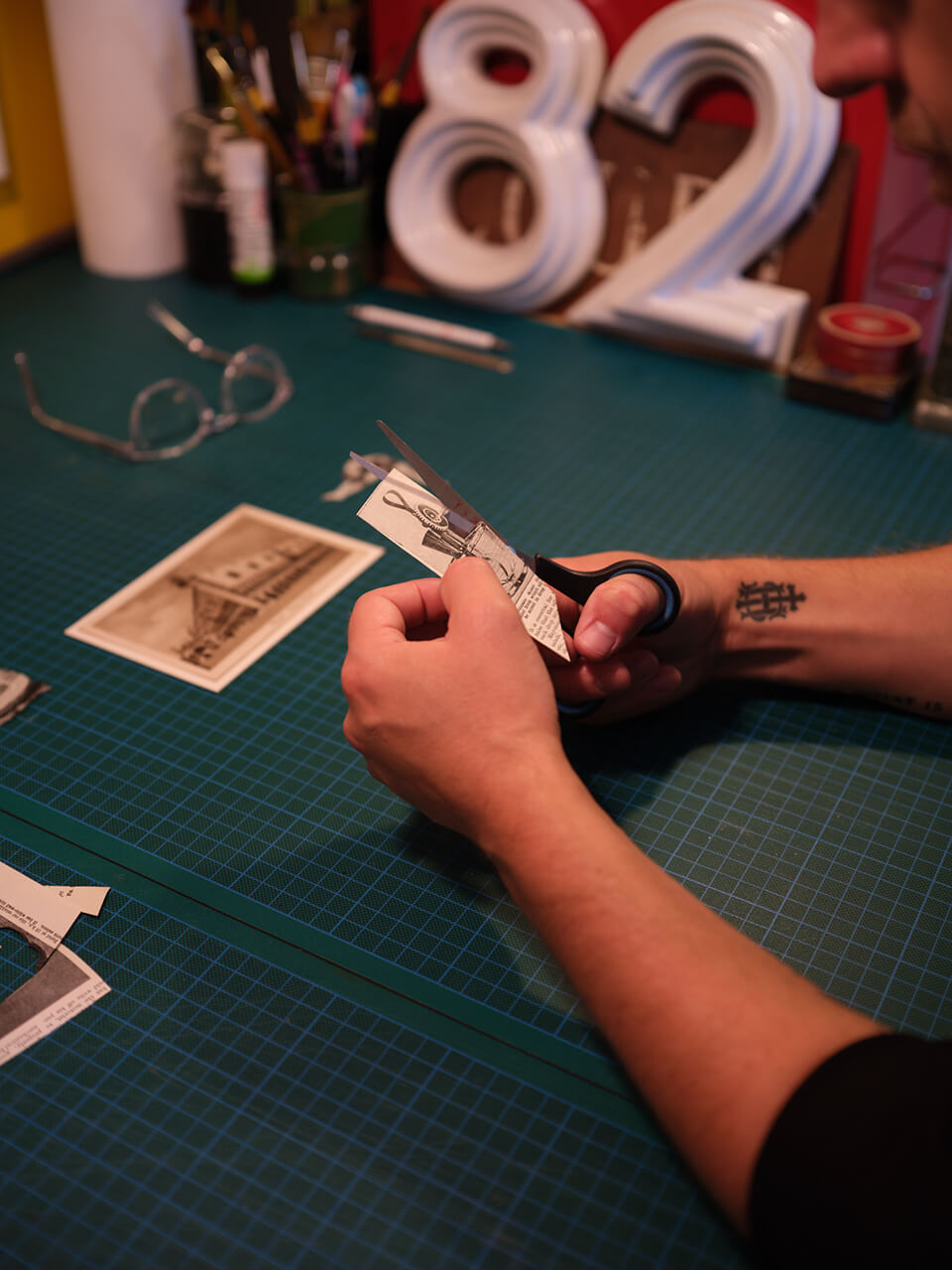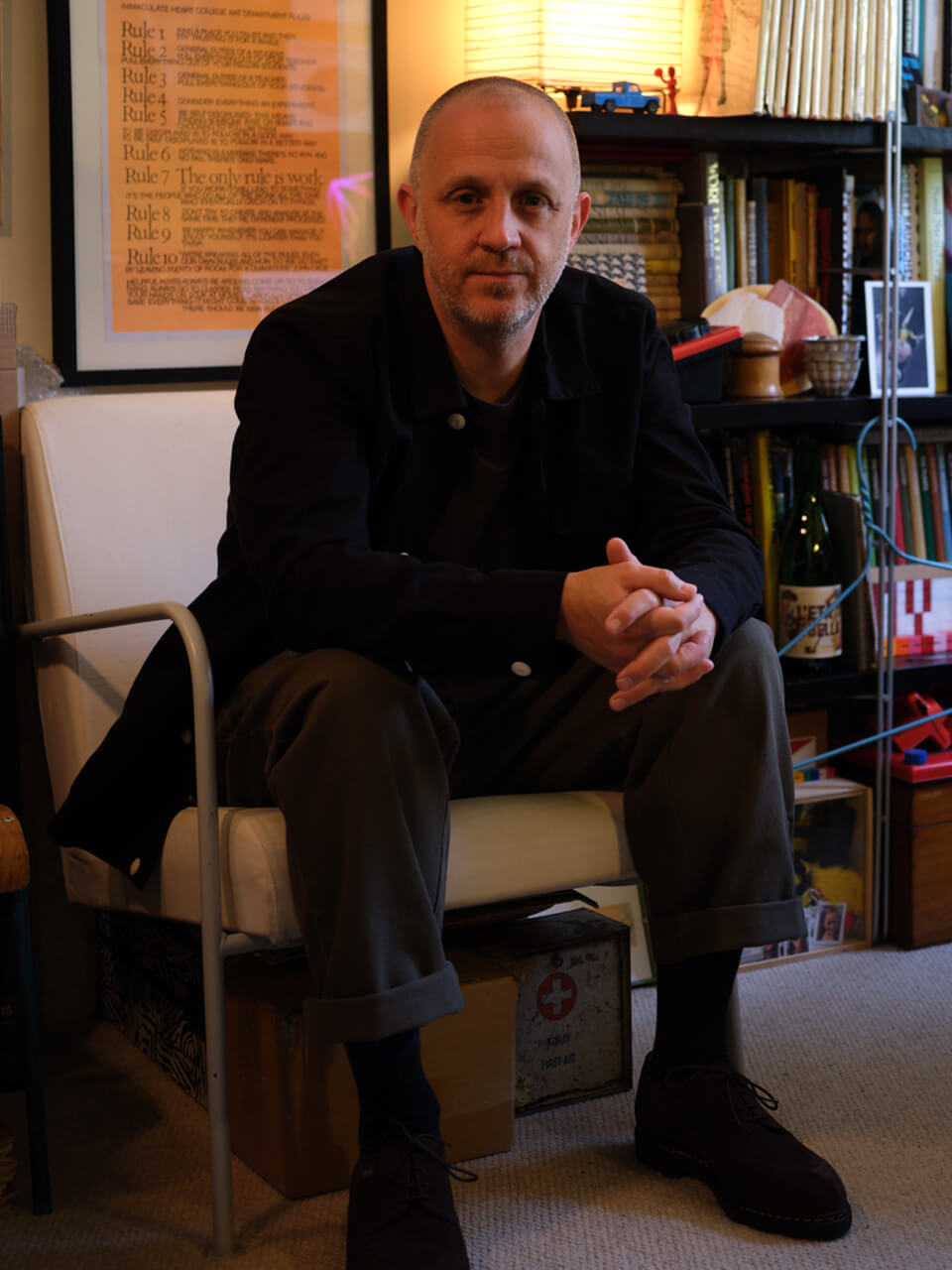A Conversation with Mark Lazenby
Mark Lazenby is a British collagist, with a distinctive visual language he’s developed over the course of a career spanning more than 30 years. By turns absurdist and beautiful, his work explores the tradition of early Dada collagists artists such as Kurt Schwitters and Max Ernst, but with its own unique set of preoccupations. We spoke with Mark about the gulf between physical and digital media, making work from the scraps, and being a hoarder.

I’m going to start with a pretty broad question, and ask you how a collage takes shape.
I have different ways that I work, and it partly depends on how I’m feeling. Sometimes I have pieces that have been growing for a while that I’ve made lots of notes about. I’m working on one now that I planned about three years ago, but I’ve not felt at the stage where I’ve been ready to make it, for whatever reason.
Whereas other times I’ve found something – from trawling markets or antiques shops, or book shops, or eBay – that just grabs me, and I think, “I’m gonna do something with that.” I don’t have a particular idea, but I have two things that I want to merge from disparate places. I usually keep all the outside offcuts of stuff, which I can then trawl back through and make something completely fragmented, again, without any particular plan at the beginning. Just letting it build and seeing where it goes, and enjoying the process. It’s a bit more freeing.
Does being a collage artist require a rigorous approach to filing and storage?
[Laughs] It probably should! I know other people that have drawers in their studios that are labelled ‘Chickens,’ or ‘Fruit,’ but mine… Everything has a place, and most of it I know where it might be, but I do get to the odd point where I’ve got an idea and I desperately need a grapefruit, and in my head I know I’ve got a really amazing grapefruit somewhere. I’ve got a big chest full of stuff, I’ve got suitcases and boxes and drawers, so sometimes you’ve just got to tip everything out. Or I’ve got to go out and find another one.

Does the not being able to find something become part of the work? Can that unpredictability make it more rewarding?
Yeah, I think so. I like to leave space in the work for there to be accidents or mistakes. I want to surprise myself, and I want to surprise other people. I do have a lot of stuff collected, but for me I’ve always enjoyed going on the hunt for something. In the early days I was quite precious, so if I did find a nice print or a postcard, or a book, I probably wouldn’t use that, I’d use a photocopy, or do a screen print or something, and then use that.
If I’ve got an idea, I need to move on it quickly, I can’t wait three months to find the perfect grapefruit. I might hunt around on eBay or go to the bookshop and see if they’ve got something, but it’s a healthy limitation and it keeps it fresh. Years back I used to do a lot of commissions for magazines and newspapers, which I started off doing by hand, but then it got to the point where, say, someone from the Guardian would say, “Can you do a piece, we need it tomorrow morning,” [laughs]. I didn’t have the luxury of doing it by hand, so most of it ended up digital. But I didn’t like the results as much, so I stopped years back. Doing stuff digitally, it had too much choice.

A lot of your work is series based. Are you letting the feel of it guide you, or are you trying to pursue any particular motifs or themes?
Most of my stuff starts with words, so I jot stuff down, and then I do slightly terrible little rough drawings. I fell into doing series of things without even meaning to, but I find it a really helpful discipline, it kind of takes the pressure off and just means that you can continually work and play and keep yourself ticking over.
I did a series called Make Mountains that involved me cutting out hundreds of church towers from a series of old books that I’d found. I removed the church towers, and even from the first one that I did I loved what I was left with: the sky and the trees, and the graveyards, and the hedges, and then a big gap in the middle. Then, literally just by taking that and laying it over something else, I started growing a whole series of well over 70 pieces. The side bit of it, the bit that I was supposed to throw away, it became the focus.

And is it easy to walk away from a piece and call it finished?
Some of them do feel like a bit of a struggle. Sometimes they just flow, whereas other times it can be a bit painful, which is ridiculous to say when you’re pushing bits of paper around [laughs].
I would say that I’m easily pleased, but I’m not easily pleased, that sounds wrong. I do get a good sense of when something’s finished, and I suppose part of that is having overworked things when I was younger. And that’s the other thing about working with a physical collage: once you’ve cut something out and stuck it down, you can’t really take it off. You can cover it up, whereas in Photoshop you can just turn that layer off or undo that terrible accident [laughs]. Which, again, I think lends itself to you overworking something, or it becoming boring.

Finally, I’m interested to know how your studio space influences the work itself.
I think because I’m surrounded by all the stuff I need to make the work, that has formed exactly how the studio looks. My wife is very minimal, and I’m very maximal and a collector of things, so our house is fairly sparse apart from this room. I’m running out of space, because I’m surrounded by piles of books and suitcases full of bits of paper, but it definitely is the place where I feel the most me. I am slightly worried I’m going to cave myself in like a massive hoarder. I mean it all has its place, and it is fairly tidy, especially after I tidied it up the other day for the shoot, but if I don’t get more space I will probably end up boxed in. I’ll feature on some terrible TV show in 20 years where they have to dig me out, which is why I’ve got to keep making [laughs]. Collaging is stopping me from entombing myself like an Egyptian pharaoh.

Mark Lazenby lives and works in Hertfordshire. He has an MA from the Royal College of Art (a ‘Masters in cutting and sticking,’ as his mum affectionately terms it), and has exhibited his work all over the world.
Interview by Nathan Sharp, Photography by John Spinks
Shop new season arrivals
